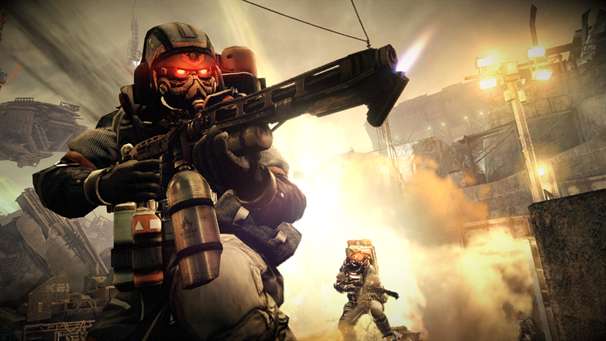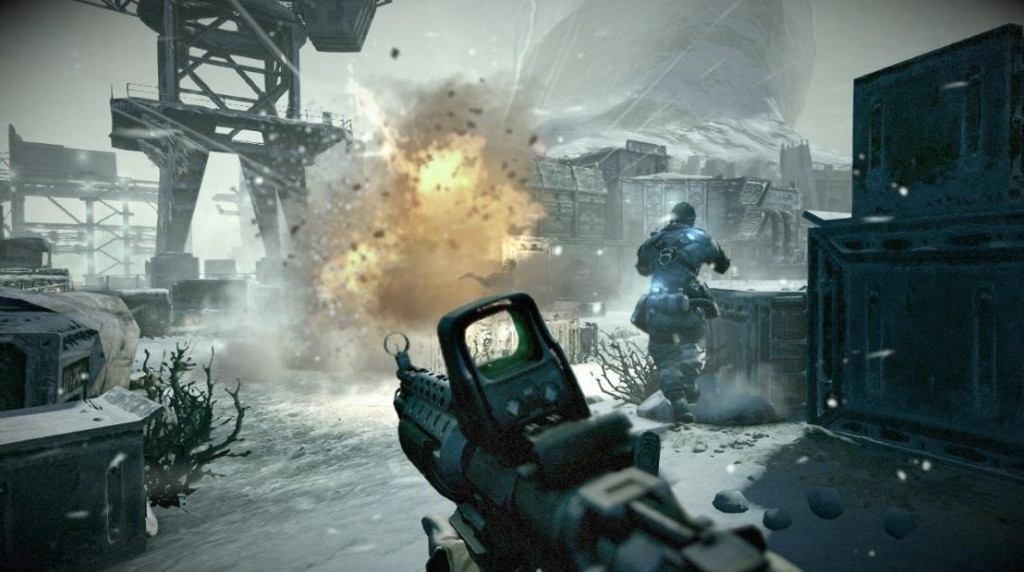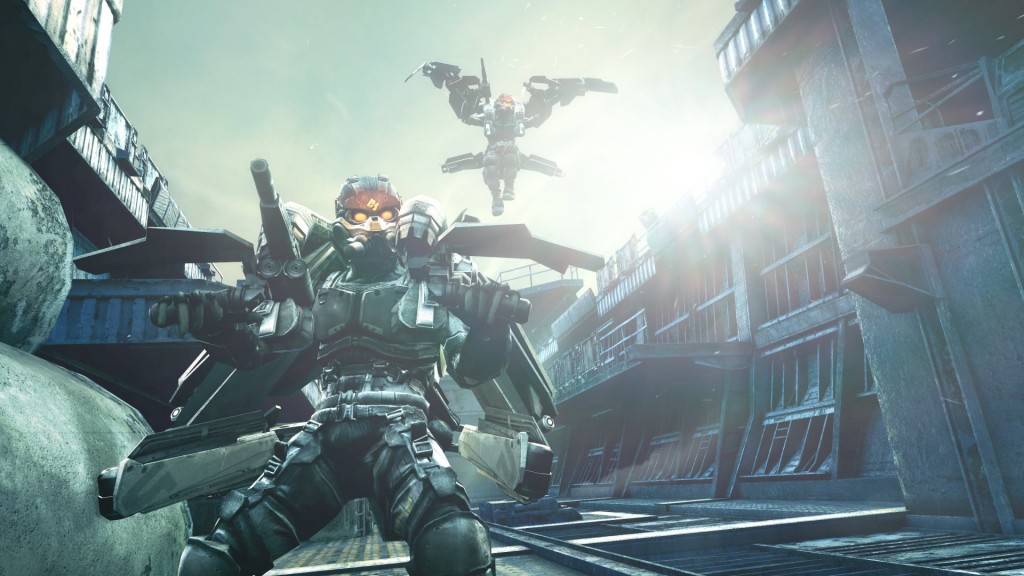Killzone is a series that has always confused me. It always wanted to be a Halo-killer, but it chose to have mechanics that resembled Call of Duty on paper and a garbage barge in execution. That is, the idea of these massive combat action sequences, but your character moves with a real-world weight, an actual heft that is thrown around, rather than the frictionless world of Call of Duty. It tried to be this tough, character driven game, but most of the characters fell flat or were just plain obnoxious (looking at you, Rico). It has always felt, and Killzone 3 is no exception, that this franchise never quite came together in a way Sony wanted.
This isn’t to say Killzone 3 is bad. Not in the least; in fact it gets a lot of things right. Graphics are amazing, levels are varied (there’s actual color in some of the levels, unlike KZ2!), and there are some satisfying moments sprinkled throughout. It is just that it all comes together in a package that is so thoroughly average that it becomes a bit of a disappointment. I’ll start this off with the positive thoughts:
The graphics: Good God are they gorgeous. Some great character models (unless you’re a random ISA soldier), and the vehicle designs are insanely good looking. I don’t think anyone will ever contest that Killzone 3’s graphics are amazing, but some might have issue with the style. Personally, I think if there’s one aspect the developer nailed is the differences between the ISA and the Helghast, because it is always obvious to what faction both equipment and characters belong. Hell, the common faceless foot-soldier of the Helghast has been front and center during the marketing, because that red-eyed mask is just an excellent design, from concept through execution.
Motion-controls: Killzone 3 is one of the first AAA titles to support Sony’s motion controller, the Playstation Move. Now, I’ve never fallen in love with the Wii, and I’ve owned one since launch. I was skeptical of the Move, but thought SOCOM 4 at E3 felt amazing, so I wanted to give it another chance. I’ve completed all of the single player campaign using only the Move and I have to say……motion controls still have a way to go for a full on, “you gotta use it” recommendation. That being said, I found the Move perfectly functional, and I even found some moments where I was thankful to be using it. Precision shooting with this thing is satisfying, and becomes even more satisfying once obstacles start flying your way. The controller is so sensitive that the pulse in my hand will slightly shake it, and the vibration from getting hit really throws you off. These may sound like annoyances, but they actually aided the immersion, because I had to control my own pose in order to line up some of the shots (especially sniper shots). Melee attacks with the Move also felt great, but we’ll talk about those in a second. My only concern would be when turning, as the Move felt a little slow on this end. These settings are all customizable, so maybe I just need to tweak them. The biggest problem comes from the gun on screen; it follows the Move, and sometimes ends up taking up so much screen real estate that I felt like I was admiring the gun more than the action.
Melee attacks: Yes, these get their own section, simply because the Brutal Melee system of Killzone 3 might be the greatest thing in it. Say you’re running down a hallway and one of the Helghast steps out in front of you. Do you just push a button and smack him backwards? NO. You do the melee attack and suddenly you’re popping both your thumbs through the eyeholes of his helmet, sending blood down your hand. Maybe you pull his head back and stab him in the chest. Perhaps you pull his face downward, onto your waiting knife. Or, if you’re really lucky, you kick out his legs and then continue the combo in the environment. Some may argue that this instant kill melee system may cheapen the game, but I disagree. You have to be extremely close to pull it off, and getting close to your enemy in Killzone is practically a death sentence. No word on how much it affects balance online, but I find the mechanic so damned delightful that I would be disappointed to see them pull it.
At this point, it is time to discuss the bad. Looking back, I now see that I’m writing a tome about Killzone, so let me wrap this up quickly.
“Why aren’t I doing that?”: Here’s Killzone 3′s biggest folly. The levels are short. Incredibly short. There are some moments where a level will load, you’ll go through ONE firefight (usually a ten/fifteen minute fight) and then you’ll be loading a new level. This wouldn’t be a big deal, but it happens a lot, usually when a rather large robot is on screen doing something with lots of particle effects. What I’m suggesting is perhaps there needs to be more optimization of the graphics engine, because constantly putting us in these massive set pieces, but dividing them into little un-filling morsels, may do more harm than good. This problem is exacerbated when all these moments end with little cutscenes of your character doing something mind-blowingly cool, like running away from a massive explosion while everything falls apart around them. The thing is, if I’m playing a video game, let me play the game. It got really frustrating, because it felt like I was a vessel for the character to get to the cinematic and unique experiences, then someone else came in the room and took the controller for those moments. Again, this wouldn’t have been a problem if it didn’t happen in almost every level.
Sync: Some copies of Killzone 3 are apparently slightly out of sync in terms of video/audio signal. My copy always seemed about a frame behind, so audio always felt a little laggy. There’s really no excuse for this in a AAA title.
What on Earth (or Helghan) is going on? Killzone 3 wants to be this cinematic experience, but fails on two major fronts. First, it wants to be this major rollercoaster for the player, yet suffers from a lack of good filmmaking fundamentals. When you watch a film, shots cut from one to another, in a way that makes sense to you the viewer. The person who does this editing is called, naturally, an editor. I don’t mean to turn this into a basic film theory class, but it was clear that no one at Guerrilla has ever seen a well-cut action sequence, and they clearly didn’t have an actual editor for their cutscenes. People pop in and out of scenes, some sequences aren’t exciting at all (and when that sequence is a car chase, you’ve messed up), and (second) the story progression alternates between rushing and stagnating so often that you’ll get whiplash. My favorite example would be towards 2/3 through the game. You escape from this base and send the rest of your soldiers (except for Rico, because you’re his only friend or some BS like that) off on a mission while you volunteer to go after another character. This is a fine cutscene. What isn’t fine is having the next level load, and suddenly I’m in this crazy vehicle that I didn’t see in the scene nor was it mentioned by anyone! If I hadn’t managed to see the vehicle in the last level, I would have been super confused, but I only found it by chance.
The writing: I found the storylines involving the Helghan council more interesting, but that might be obvious when Malcolm McDowell and Ray Winstone (through really smart uses of motion capture) are acting on that side. However, I’m forced to play as the ISA, meaning every conversation I have centers around my commander and Rico arguing about orders. Every single time, Rico suggests an idea, gets shot down, then complains about the captain. This would mean something, if the captain wasn’t right 90% of the time. Naturally, eventually he makes a mistake and finally listens to Rico, like he was this clairvoyant battlefield genius. Which brings me to my final point…
No one likes Rico. Because he’s a pain in the ass.





2 Comments
Very interesting, I know just enough to not buy it now. 😉 Rockin’ Review.
Audio lag in a AAA title???!!! WTF?! They dis sound, they dis my soul.
Nailed it. I love FPS’s but I couldn’t even finish this PoS.